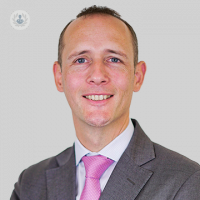Breast reconstruction surgery: what are my options?
Written in association with:Following breast cancer surgery, some women choose to have a breast reconstruction to restore the appearance of their affected breasts. There are a number of different techniques available, each with their own advantages and disadvantages. Mr Kieran Power, a leading plastic surgeon, summarises the different types of reconstruction available.

What types of reconstructive breast surgery are there?
There are a range of surgical techniques to reconstruct a breast. Some are relatively simple, such as implant-based techniques and some are more complex, such as the flap-based techniques. ‘Flap’ refers to using your own tissues. Implant-based techniques aim to reconstruct a breast mound which looks good in clothing. In general, it can be difficult to reconstruct a natural-looking breast, but flap-based techniques can better achieve this. However, flap-based techniques involve more complex surgery with longer surgery and longer recovery times. They are also associated with scars in the donor site. They do have the longer-term advantages in that they produce more natural-looking breasts which age naturally and require less revision surgery. Implant-based procedures, however, often do require revision surgery after a number of years.
What is nipple reconstruction and how is it done?
Nipple reconstruction is a method to recreate the semblance of a nipple on a reconstructed breast. Sometimes during breast cancer surgery, the nipple is removed as part of this procedure. There are a range of techniques to achieve this part of a reconstruction. The most common technique is to use local flaps which involves raising small skin flaps on the reconstructed breast and folding them into the shape of the nipple. Once this is fully healed, then tattooing is performed to match the pigmentation of your natural breasts. Another technique is nipple sharing, which involves taking a portion of the nipple from your other breast and grafting it onto the reconstructed breast. In some cases, you may be advised just to have a nipple tattoo, particularly if the skin is very thin on the reconstruction or if you have had radiotherapy. Another option is stick-on nipples which are silicone nipples which have been created to match your natural breasts and these can be applied to the reconstruction.
Can breast cancer return after breast reconstruction?
Unfortunately, I think we all know breast cancer can recur after breast reconstruction. However, there is no evidence to suggest that having a reconstruction at the time of your mastectomy or as a delayed reconstruction after your cancer treatment, influences that risk of recurrence. We know that there are a lot of benefits to having a reconstruction. It improves recovery, improves self-confidence and body image. So, there are a lot of psychological benefits to having a reconstruction for many women and the reconstruction itself does not appear to influence the risk of recurrence.
If you have undergone breast cancer surgery and want to find out more about reconstruction options, make an appointment with an expert .


